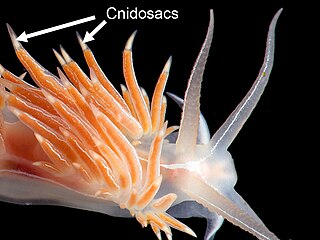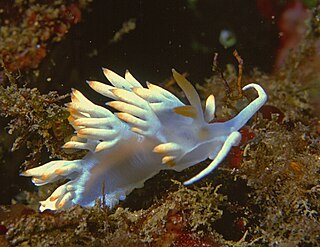
Nudibranchs are a group of soft-bodied marine gastropod molluscs which shed their shells after their larval stage. They are noted for their often extraordinary colours and striking forms, and they have been given colourful nicknames to match, such as "clown", "marigold", "splendid", "dancer", "dragon", or "sea rabbit". Currently, about 3,000 valid species of nudibranchs are known.

Sea slug is a common name for some marine invertebrates with varying levels of resemblance to terrestrial slugs. Most creatures known as sea slugs are gastropods, i.e. they are sea snails that over evolutionary time have either completely lost their shells, or have seemingly lost their shells due to having a greatly reduced or internal shell. The name "sea slug" is most often applied to nudibranchs, as well as to a paraphyletic set of other marine gastropods without obvious shells.

Glaucus atlanticus is a species of small, blue sea slug, a pelagic (open-ocean) aeolid nudibranch, a shell-less gastropod mollusk in the family Glaucidae.

Glaucus marginatus is a species of small, floating, blue sea slug; a pelagic (open-ocean) aeolid nudibranch; a marine opisthobranch gastropod mollusc in the family Glaucidae. This species is closely related to Glaucus atlanticus, and is part of a species complex along with Glaucus bennettae, Glaucus thompsoni, and Glaucus mcfarlanei. Like Glaucus atlanticus, it is commonly known as a blue dragon.

Cerata, singular ceras, are anatomical structures found externally in nudibranch sea slugs, especially in aeolid nudibranchs, marine opisthobranch gastropod mollusks in the clade Aeolidida. The word ceras comes from the Greek word "κέρας", meaning "horn", a reference to the shape of these structures.

The purple lady nudibranch, Paraflabellina funeka, is a species of aeolid nudibranch, and is a very colourful sea slug. It is a marine gastropod mollusc in the family Flabellinidae.

The white-edged nudibranch, Fjordia capensis, is a species of sea slug, specifically an aeolid nudibranch, a very colourful sea slug. It is a marine gastropod mollusc in the family Flabellinidae.

Trinchesia speciosa, common name the "candy nudibranch", is a species of sea slug, an aeolid nudibranch, a marine gastropod mollusc in the family Trinchesiidae.
The black-dot nudibranch, Caloria sp. 1, as designated by Gosliner, 1987, is a species of sea slug, specifically an aeolid nudibranch. They are marine gastropod molluscs in the family Facelinidae.
The yellow-tipped nudibranch, Caloria sp. 2, as designated by Gosliner, 1987, is a species of sea slug, specifically an aeolid nudibranch, a marine gastropod mollusc in the family Facelinidae.

Cratena capensis, the orange-eyed nudibranch, is a species of sea slug, specifically an aeolid nudibranch. It is a marine gastropod mollusc in the family Facelinidae.

Pteraeolidia ianthina is a sea slug, an aeolid nudibranch in the family Facelinidae. It is known as a blue dragon, a name it shares with Glaucus atlanticus and Glaucus marginatus.

Luisella babai is a species of sea slug, an aeolid nudibranch, a marine gastropod mollusc in the family Samlidae.

Coryphellina rubrolineata is a species of sea slug, an aeolid nudibranch, a marine heterobranch mollusc in the family Flabellinidae.

A cnidosac is an anatomical feature that is found in the group of sea slugs known as aeolid nudibranchs, a clade of marine opisthobranch gastropod molluscs. A cnidosac contains cnidocytes, stinging cells that are also known as cnidoblasts or nematocysts. These stinging cells are not made by the nudibranch, but by the species that it feeds upon. However, once the nudibranch is armed with these stinging cells, they are used in its own defense.

Cerberilla africana is a species of sea slug, an aeolid nudibranch, a marine heterobranch mollusc in the family Aeolidiidae.

Cerberilla albopunctata is a species of sea slug, an aeolid nudibranch, a marine heterobranch mollusc in the family Aeolidiidae.

Cerberilla ambonensis is a species of sea slug, an aeolid nudibranch, a marine heterobranch mollusc in the family Aeolidiidae.
Cerberilla potiguara is a species of sea slug, an aeolid nudibranch, a marine heterobranch mollusc in the family Aeolidiidae.
Cratena minor is a species of sea slug, an aeolid nudibranch, a marine gastropod mollusc in the family Facelinidae.















